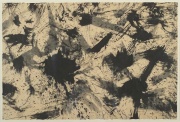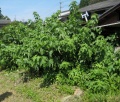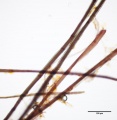Difference between revisions of "Kozo"
JMcGlinchey (talk | contribs) |
|||
| (11 intermediate revisions by 3 users not shown) | |||
| Line 1: | Line 1: | ||
| − | [[File:1999.706-SC9584.jpg|thumb|]] | + | [[File:1999.706-SC9584.jpg|thumb|Collage on mulberry paper; MFA# 1999.706]] |
== Description == | == Description == | ||
| − | + | [[File:2002.145-SC37950.jpg||thumb|Kozo/Paper Mulberry<br>MFA# 2002.145]] | |
| − | Kozo is used as a general term for Japanese | + | Kozo is used as a general term for Japanese paper made from the inner bark of mulberry trees, such as the [[mulberry paper]] ''Broussonetia papyrifera'' and [[bast fiber|bast]] paper fibers harvested from that plant. Kozo papers are often used for backing when Asian scrolls are [[lining paper|relined]]. Kozo is an important paper fiber in traditional Japanese, Korean, and Chinese hand-papermaking. The inner bark requires little chemical intervention to create high quality, long fibers that are low in lignin. The long fiber length and high percentage of [[alpha cellulose]] impart strength to Kozo papers. |
== Synonyms and Related Terms == | == Synonyms and Related Terms == | ||
| Line 8: | Line 8: | ||
kozo paper; paper mulberry; torinoko (at least 20% kozo); hosho (thick); moriki (delicate) | kozo paper; paper mulberry; torinoko (at least 20% kozo); hosho (thick); moriki (delicate) | ||
| − | + | == Physical and Chemical Properties == | |
| − | == | ||
Paper fiber type: non-woody/bast. Using transmitted light microscopy, fibers appear thick walled with varying width. A distinct cuticle layer is present on the outside of fibers. Dislocations and cross-markings are present, but faint. Appearance with [[Graff "C" stain]]: purple-red, ranging from light to dark. Average dimensions of fibers: length 10mm, width 30 μm. Common pulping method: prepared by retting and mechanical separation. | Paper fiber type: non-woody/bast. Using transmitted light microscopy, fibers appear thick walled with varying width. A distinct cuticle layer is present on the outside of fibers. Dislocations and cross-markings are present, but faint. Appearance with [[Graff "C" stain]]: purple-red, ranging from light to dark. Average dimensions of fibers: length 10mm, width 30 μm. Common pulping method: prepared by retting and mechanical separation. | ||
| Line 15: | Line 14: | ||
<gallery> | <gallery> | ||
| − | File: | + | File:Kozo.jpg|thumb|Kozo/Paper Mulberry |
File:kozo_proc_det.jpg|Kozo | File:kozo_proc_det.jpg|Kozo | ||
| − | File:Kozo 40x.jpg|Kozo fibers stained with Graff "C" Stain | + | File:Kozo 40x.jpg|Kozo fibers stained with Graff "C" Stain at 40x |
File:Kozo strips.jpg|Preparation of Kozo for papermaking | File:Kozo strips.jpg|Preparation of Kozo for papermaking | ||
</gallery> | </gallery> | ||
| − | == | + | == Resources and Citations == |
* Matt Roberts, Don Etherington, ''Bookbinding and the Conservation of Books: a Dictionary of Descriptive Terminology'', U.S. Government Printing Office, Washington DC, 1982 | * Matt Roberts, Don Etherington, ''Bookbinding and the Conservation of Books: a Dictionary of Descriptive Terminology'', U.S. Government Printing Office, Washington DC, 1982 | ||
Latest revision as of 15:20, 5 October 2022
Description
Kozo is used as a general term for Japanese paper made from the inner bark of mulberry trees, such as the Mulberry paper Broussonetia papyrifera and bast paper fibers harvested from that plant. Kozo papers are often used for backing when Asian scrolls are relined. Kozo is an important paper fiber in traditional Japanese, Korean, and Chinese hand-papermaking. The inner bark requires little chemical intervention to create high quality, long fibers that are low in lignin. The long fiber length and high percentage of Alpha cellulose impart strength to Kozo papers.
Synonyms and Related Terms
kozo paper; paper mulberry; torinoko (at least 20% kozo); hosho (thick); moriki (delicate)
Physical and Chemical Properties
Paper fiber type: non-woody/bast. Using transmitted light microscopy, fibers appear thick walled with varying width. A distinct cuticle layer is present on the outside of fibers. Dislocations and cross-markings are present, but faint. Appearance with Graff "C" stain: purple-red, ranging from light to dark. Average dimensions of fibers: length 10mm, width 30 μm. Common pulping method: prepared by retting and mechanical separation.
Additional Images
Resources and Citations
- Matt Roberts, Don Etherington, Bookbinding and the Conservation of Books: a Dictionary of Descriptive Terminology, U.S. Government Printing Office, Washington DC, 1982
- Book and Paper Group, Paper Conservation Catalog, AIC, 1984, 1989
- The Dictionary of Paper, American Paper Institute, New York, Fourth Edition, 1980
- Marja-Sisko Ilvessalo-Pfäffli. Fiber Atlas: Identification of Papermaking Fibers (Springer Series in Wood Science). Springer, 1995.
- Walter Rantanen. "Fiber ID Course." Integrated Paper Services. June 2013. Lecture.
- Bernard Toale, The Art of Papermaking, Davis Publications, Portland OR, 1983
- Art and Architecture Thesaurus Online, http://www.getty.edu/research/tools/vocabulary/aat/, J. Paul Getty Trust, Los Angeles, 2000





